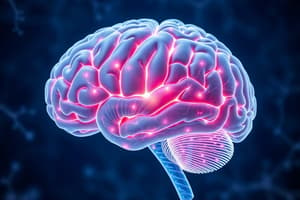Podcast
Questions and Answers
What part of the brain stores patterns of movement and habits?
What part of the brain stores patterns of movement and habits?
- Midbrain
- Hindbrain (correct)
- Corpus callosum
- Cerebrum
Which part of the brain is responsible for controlling eye movements?
Which part of the brain is responsible for controlling eye movements?
- Midbrain (correct)
- Cerebellum
- Cerebrum
- Brainstem
What is the function of the corpus callosum?
What is the function of the corpus callosum?
- Facilitate communication between brain hemispheres (correct)
- Store patterns of movement
- Control eye movements
- Coordinate some voluntary movements
Which part of the brain is crucial for regulating essential body functions like breathing and heart rate?
Which part of the brain is crucial for regulating essential body functions like breathing and heart rate?
What is grey matter in the brain composed of?
What is grey matter in the brain composed of?
How do neurons in the brain communicate with each other?
How do neurons in the brain communicate with each other?
What is the forebrain primarily responsible for?
What is the forebrain primarily responsible for?
Which part of the brain controls some reflexive actions and is involved in eye movements?
Which part of the brain controls some reflexive actions and is involved in eye movements?
What is the main function of the cerebellum?
What is the main function of the cerebellum?
Which part of the brain is primarily responsible for conscious thoughts and actions?
Which part of the brain is primarily responsible for conscious thoughts and actions?
What are the three main divisions of the brain?
What are the three main divisions of the brain?
Flashcards are hidden until you start studying
Study Notes
Introduction: The Human Brain
The human brain is a marvel of evolution and biology. It is the command center of the body and the source of all our intellectual capabilities, emotions, and behaviors. Despite being a single organ, it is incredibly diverse and complex. With billions of neurons and countless connections between them, it is responsible for producing our thoughts, actions, memories, feelings, and overall perception of the world. Let's delve deeper into the fascinating structure, function, and intricacies of this magnificent organ hereafter referred to as the "brain".
Structure of the Brain
The brain can be broadly divided into three main units: the forebrain, midbrain, and hindbrain. The forebrain is primarily responsible for intellectually processing information from the senses and planning actions. It consists of the cerebrum and structures hidden beneath it. The midbrain controls some reflexive actions and is part of the circuit involved in eye movements. The hindbrain includes the upper spinal cord, brain stem, and cerebellum. The cerebellum coordinates movement and is involved in learned movements. Additionally, parts of the hindbrain control vital body functions such as respiration and heart rate.
Forebrain
The forebrain is the largest and most developed part of the human brain, consisting primarily of the cerebrum and structures hidden beneath it. The cerebrum sits atop the brain, responsible for conscious thoughts and actions. It holds memories and enables planning, imagination, recognition of friends, reading, and playing games. The cerebrum is split into two hemispheres—left and right—which communicate through the corpus callosum, a thick tract of nerve fibers.
Midbrain
The midbrain controls reflexive actions and is part of the circuit involved in controlling eye movements. It also retains primitive functions such as coordinating some voluntary movements.
Hindbrain
The hindbrain contains the uppermost part of the spinal cord, brainstem, and a wrinkled ball of tissue called the cerebellum. The cerebellum stores patterns of movement, habits, and repeated tasks. It coordinates movement and is involved in learned movements. The hindbrain is crucial for regulating essential body functions like breathing, heart rate, blood pressure, sleep patterns, and signaling between the brain and the rest of the body.
Functions of the Brain
Nerve Cells and Connectivity
Each neuron in the brain can make contact with thousands or even tens of thousands of others via tiny structures called synapses. These connections change constantly throughout life, forming new ones and pruning excess ones. Memories are stored through a strengthening of these connections, shaped partly by genes but largely by experiences.
Grey Matter and White Matter
Grey matter refers to the cell bodies of neurons, while white matter consists of the branching network of dendrites and axons that spread out from neurons. There are also glial cells, which amplify neural signals and are as important as neurons in mental calculations.
Neurons and Communication
Neurons in the brain communicate through the release and capture of neurotransmitter and neuromodulator chemicals, such as glutamate, dopamine, acetylcholine, noradrenaline, and serotonin, that regulate bodily functions and mood.
Memory Storage
Memories are stored in the changing pattern and strength of connections between neurons. New brain cells are being born throughout our lives, contributing to memory formation.
Conclusion
The human brain is a testament to the power of evolution and biology. Its intricate structure and functions are essential for our survival and quality of life. As science continues to unravel the mysteries within this complex organ, we gain a deeper understanding of what makes us truly human—our thoughts, experiences, and perception of the world around us.
Studying That Suits You
Use AI to generate personalized quizzes and flashcards to suit your learning preferences.




